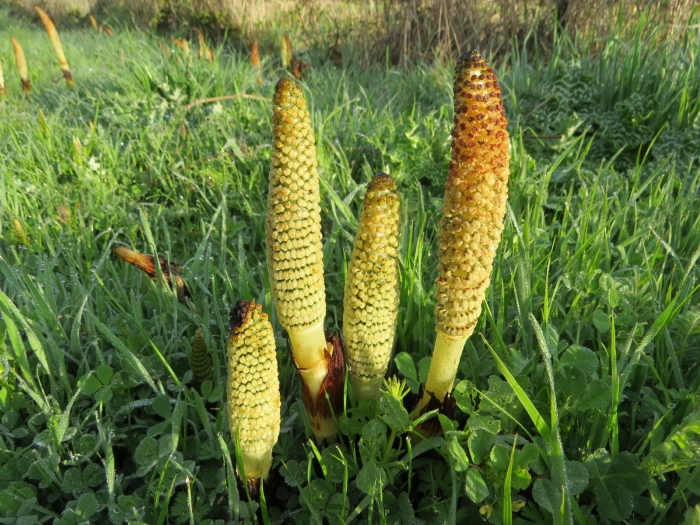Great Horsetail
(Equisetum telmateia)
Great Horsetail (Equisetum telmateia)
/
/

Garth Harwood
CC BY 4.0
Image By:
Garth Harwood
Recorded By:
Copyright:
CC BY 4.0
Copyright Notice:
Photo by: Garth Harwood | License Type: CC BY 4.0 | License URL: http://creativecommons.org/licenses/by/4.0/ | Rights Holder: Garth Harwood | Publisher: iNaturalist | Date Created: 2020-03-20T08:13:42-07:00 |

























Estimated Native Range
Summary
Equisetum telmateia, commonly known as Great Horsetail or Northern Giant Horsetail, is a perennial herb native to riparian zones, wet woodlands, and moist, open fields in Europe, western Asia, northwest Africa, and western North America. It typically grows to a height of 2-4 feet (0.6-1.2 meters). This species is characterized by its separate green sterile stems, which are jointed and ridged, and pale yellowish fertile stems that appear earlier in the season and bear spore cones at their tips. The sterile stems emerge after the fertile stems and can be quite striking with their bushy appearance.
Great Horsetail is valued for its architectural form and prehistoric appearance, making it a unique addition to water gardens, bog gardens, and other moist cultivation areas. It thrives in full sun to part shade, preferring consistently wet soil conditions. It is a useful plant for soil stabilization along water bodies due to its extensive rhizome system. However, this same rhizome system can make it aggressive, and it may become invasive outside its native range. Care should be taken to control its spread in garden settings. Equisetum telmateia has been used traditionally for its high silica content, which was thought to be beneficial for hair and nail growth.CC BY-SA 4.0
Great Horsetail is valued for its architectural form and prehistoric appearance, making it a unique addition to water gardens, bog gardens, and other moist cultivation areas. It thrives in full sun to part shade, preferring consistently wet soil conditions. It is a useful plant for soil stabilization along water bodies due to its extensive rhizome system. However, this same rhizome system can make it aggressive, and it may become invasive outside its native range. Care should be taken to control its spread in garden settings. Equisetum telmateia has been used traditionally for its high silica content, which was thought to be beneficial for hair and nail growth.CC BY-SA 4.0
Plant Description
- Plant Type: Fern
- Height: 4-5 feet
- Width: 3-4 feet
- Growth Rate: Rapid
- Flower Color: N/A
- Flowering Season: Non-Flowering
- Leaf Retention: Evergreen
Growth Requirements
- Sun: Full Sun, Part Shade
- Water: High
- Drainage: Medium, Slow
Common Uses
Border Plant, Deer Resistant, Erosion Control, Low Maintenance, Rabbit Resistant, Water Garden
Natural Habitat
Native to riparian zones, wet woodlands, and moist, open fields
Other Names
Common Names: Giant Horsetail, Great Horsetail
Scientific Names: , Equisetum telmateia, Allostelites maximum, Allostelites maximum var. serotinum, Equisetum caenosum, Equisetum ebernum, Equisetum eburneum, Equisetum eburneum, Equisetum eburneum, Equisetum eburneum var. frondescens
GBIF Accepted Name: